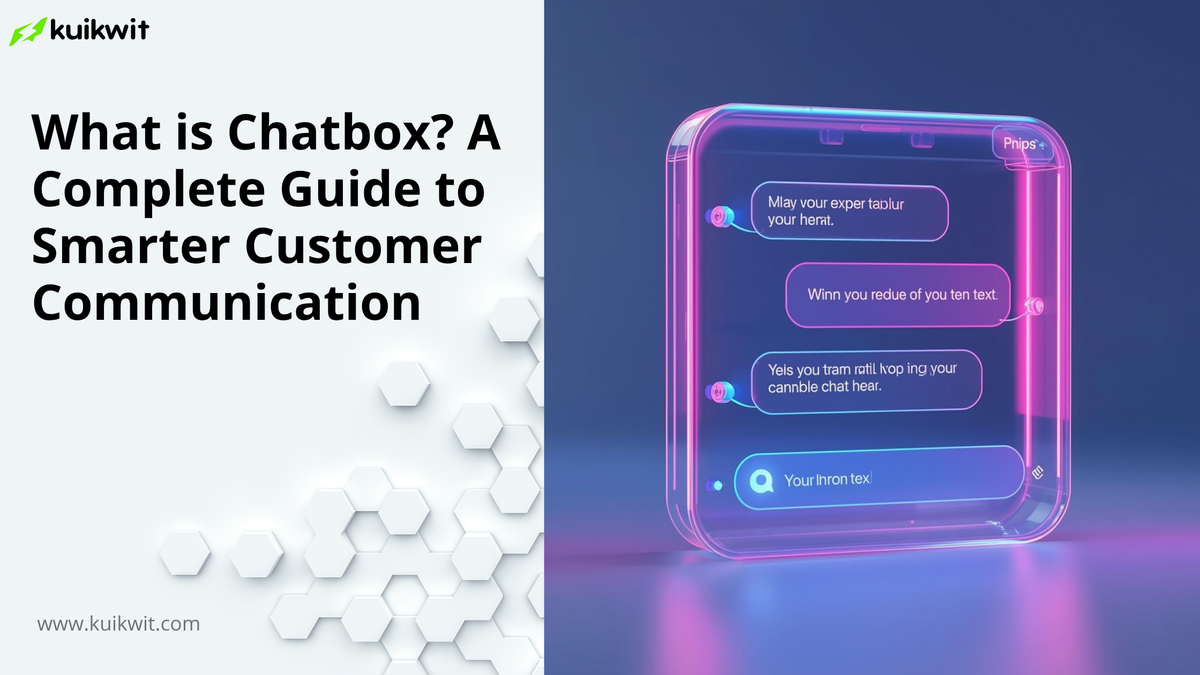What is Chatbox? Complete Guide to Virtual Chat, Chat Support & Communication in 2025 | Kuikwit
Learn what a chatbox is, how it works, and why it’s vital for chat communication, virtual chat, and chat support. Explore free chat box tools and chat home base systems.

In today’s digital-first world, real-time communication is what sets great businesses apart from the rest. Customers no longer want to wait hours or even days for replies they expect instant, helpful, and human-like responses.
This is where the chatbox (or chatbot) comes in a simple yet powerful tool that has completely changed how brands communicate with their customers.
But what exactly is a chatbox? How does it work? And why is it becoming a must-have for every business in 2025?
Let’s dive deep into everything you need to know about chatboxes from their features and benefits to real-world uses and future trends.
1. What is Chatbox?
A chatbox (also known as a chatbot or live chat widget) is an automated messaging tool that allows customers to interact with a business in real time.
It can appear as a small chat window on a website or app usually in the bottom corner where users can type their questions and instantly receive answers.
In simple terms:
A chatbox is your virtual assistant, always available 24/7 to answer questions, guide users, and provide support even when your human team is offline.
Example:
You visit an online store. A chat window pops up saying:
“Hi there! Looking for something specific? I can help you find the right product.”
That’s a chatbox engaging you instantly, saving your time, and helping the business deliver better service.
2. How Does a Chatbox Work?
A chatbox works using a combination of automation, AI (Artificial Intelligence), and pre-set scripts.
Here’s a simplified version of how it functions:
1. User Input: The customer types a question (e.g., “What are your prices?”).
2. Processing: The chatbox interprets the question using natural language processing (NLP).
3. Response: Based on pre-programmed rules or AI understanding, it replies instantly with the most relevant answer.
4. Escalation (if needed): If the chatbox can’t handle the question, it forwards it to a human chat support agent for further help.
This process takes only seconds improving chat communication and keeping customers engaged.
3. Types of Chatboxes
There are several types of chatboxes, each designed to fit different business needs and levels of automation.
a. Rule-Based Chatbox
Also known as scripted chatbots, these operate using “if-then” logic.
They respond based on specific keywords or predefined options.
Example:
User: “What are your store hours?”
Chatbox: “We’re open Monday to Friday from 9 AM to 6 PM.”
They’re simple but very effective for basic customer inquiries.
b. AI-Powered Chatbox
An AI chatbox uses machine learning and NLP to understand user intent and provide smart, human-like replies.
It learns from past interactions, improving over time.
These are great for virtual chat experiences, as they can handle complex queries and deliver personalized responses.
c. Hybrid Chatbox
A combination of both automated chat for FAQs and human chat support for deeper, emotional, or complex discussions.
Many modern businesses prefer this model because it balances efficiency and empathy perfectly.
4. The Importance of Chatboxes in Modern Business
Now that we’ve answered what is chatbox, let’s understand why it’s becoming essential for every business today.
1. 24/7 Availability
Customers might reach out at any hour even when your team is offline. A chatbox ensures round-the-clock communication, keeping your brand always accessible.
2. Faster Response Time
No one likes waiting. A chatbox responds instantly, keeping customers engaged and satisfied.
3. Cost Efficiency
Instead of hiring large support teams, businesses can automate repetitive tasks using chatboxes. This reduces costs while maintaining high-quality service.
4. Improved Customer Experience
A well-designed chatbox improves chat communication by offering personalized, friendly, and accurate answers making customers feel valued.
5. Increased Conversions
By helping customers find products, answer questions, and resolve doubts in real time, chatboxes directly boost sales and lead generation.
5. What is Chatbox Used For?
Chatboxes are incredibly versatile tools used across industries. Here are the most common use cases:
a. Customer Support
The most common use offering chat support for questions, issues, and troubleshooting.
Example: “How do I track my order?” → The chatbox provides a tracking link immediately.
b. Sales Assistance
A virtual chat assistant can help guide users through your product catalog, recommend items, or offer special deals.
c. Lead Generation
By asking visitors for their contact details, chatboxes can qualify leads automatically and send them to your sales team.
d. Appointment Booking
Many healthcare clinics, salons, and service providers use chatboxes to let customers book appointments instantly.
e. Feedback Collection
After a service or purchase, chatboxes can automatically ask: “How was your experience?” gathering valuable feedback seamlessly.
6. The Difference Between Chatbox and Live Chat
While both are used for real-time communication, there’s a key difference:
- Chatbox: Automated or AI-powered tool that handles conversations with minimal human input.
- Live Chat: Human agents reply in real time.
Many businesses combine both, using chatboxes for initial responses and transferring to live chat support when needed.
This hybrid approach improves chat communication and ensures customers always get the help they need.
7. Exploring the Concept of “Chat Box Gratuit”
If you’ve ever searched online for “chat box gratuit”, you’re probably looking for free chatbox tools.
A chat box gratuit is a free version of a chatbox software that allows businesses to test live chat and automation features without paying upfront.
These free versions often include:
- Basic chatbot setup
- Limited customization
- Simple analytics
They’re great for small businesses just starting out with chat home base tools or looking to explore virtual chat before committing to paid plans.
8. Chat Base: The Brain Behind Smart Chatboxes
A chat base refers to the data and intelligence foundation behind a chatbox.
Think of it as the “brain” that helps your chatbox understand what users are asking.
It includes:
- Frequently asked questions (FAQs)
- Product details
- Customer data
- Predefined responses
The stronger your chat base, the more accurate and helpful your chatbox becomes.
Many AI-powered tools use a chat base to train the system, ensuring it keeps improving with every customer interaction.
9. The Role of Chat Communication in Customer Experience
Chat communication has become one of the most preferred customer service channels today.
Why? Because it’s instant, convenient, and personal.
Instead of waiting on phone calls or emails, customers can simply open a chat window and get help within seconds.
Here’s how chat communication helps:
- Creates stronger relationships through quick engagement
- Allows businesses to handle multiple customers at once
- Provides an informal, friendly way to interact
Chatboxes enhance this by ensuring every conversation whether automated or human feels natural and helpful.
10. What is Chat Opening and Why It Matters
The chat opening is the first message your chatbox sends when a user visits your website.
This small detail has a big impact on engagement.
Example of a good chat opening:💬 “Hey there! 👋 Need help finding the perfect plan? I’m here to guide you.”
A friendly, welcoming chat opening encourages customers to start a conversation, making it easier to build trust.
11. Chat Home Base: Centralizing Conversations
A chat home base is your centralized dashboard where all chat interactions from different platforms are managed.
If you use multiple messaging apps like WhatsApp, Instagram, and Facebook, your chat home base (like Kuikwit) brings them all together in one place.
This allows your team to:
- Manage all chats from one inbox
- Assign conversations to team members
- Track customer history and preferences
It’s a game-changer for businesses that want to provide consistent, efficient chat support.
12. Virtual Chat: The Future of Online Interaction
The rise of virtual chat tools is transforming customer communication.
With the help of AI and automation, virtual chat systems can:
- Handle thousands of queries simultaneously
- Offer multilingual support
- Provide personalized recommendations
- Learn and improve continuously
Imagine your customer chatting with a virtual assistant that not only answers questions but also understands emotions, tone, and context.
That’s the power of virtual chat communication in 2025.
13. Chat Support: Your Brand’s Digital Frontline
Chat support is often the first point of contact between your brand and customers.
When done well, it builds trust, loyalty, and satisfaction.
An effective chat support system should include:
- Friendly tone and human touch
- Fast and accurate responses
- Seamless handover between bot and human
- Feedback options for quality improvement
Modern messaging platforms like Kuikwit make chat support smarter — combining automation, analytics, and team collaboration for smoother experiences.
14. Benefits of Using a Chatbox for Your Business
Here are some undeniable advantages of integrating a chatbox into your business operations:
Enhanced Customer Engagement – Real-time responses keep customers active on your site.
Time and Cost Savings – Fewer manual replies mean more efficiency.
Higher Conversions – Proactive chat prompts help close more sales.
Data Insights – Track user behavior and optimize chat responses.
Multi-Platform Management – Manage all channels from your chat home base.
15. The Future of Chatboxes
The future of chatboxes lies in AI-driven personalization and emotional intelligence.
We’ll soon see chatboxes that:
- Understand customer sentiment
- Offer voice and video chat options
- Integrate with CRM systems
- Predict customer needs before they ask
In short, chatboxes are evolving into complete virtual communication systems connecting brands and customers like never before.
16. Choosing the Right Chatbox for Your Business
When selecting a chatbox tool, look for:
- Omnichannel integration
- Automation and smart replies
- Analytics and reporting
- Security and data privacy
- Team collaboration features
Kuikwit, for instance, provides all these in one platform making it easier for businesses to manage chat communication, chat support, and virtual chat across all channels.
Conclusion
So, what is chatbox?
It’s more than just a pop-up window it’s the heart of modern chat communication, enabling faster, smarter, and more personal connections between brands and customers.
Whether it’s a chat box gratuit for startups or an advanced chat home base for growing enterprises, the goal remains the same to simplify com munication and enhance customer experience.
As we move further into the era of automation and AI, chatboxes will continue to evolve becoming more intuitive, empathetic, and indispensable for every business.
The future of communication is conversational and the chatbox is leading the way.




